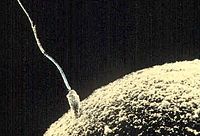- Clinical Technology
- Adult Immunization
- Hepatology
- Pediatric Immunization
- Screening
- Psychiatry
- Allergy
- Women's Health
- Cardiology
- Pediatrics
- Dermatology
- Endocrinology
- Pain Management
- Gastroenterology
- Infectious Disease
- Obesity Medicine
- Rheumatology
- Nephrology
- Neurology
- Pulmonology
More Evidence That Sperm Quality Decreases With Age
A new study suggests that DNA fragmentation and progressive motility may be more accurate and consistent predictors of sperm quality than traditionally measured traits.
Sperm and egg fusing. (Courtesy Wikipedia.)

A new, large systematic review and meta-analysis provides more evidence that a man’s sperm quality decrease as he ages, which likely affects his fertility potential.
Numerous studies have investigated age-based declines in semen traits, but the impact of paternal age on semen parameter values remains inconclusive. “Our findings indicate that male age needs more recognition as a potential contributor to the negative outcomes associated with delayed first reproduction,” state the authors, led by Dr Sheri Johnson of the Departments of Anatomy and Zoology at the University of Otago, Dunedin, New Zealand.
Dr Johnson and colleagues reviewed 90 individual studies from more than 30 countries that included nearly 94,000 volunteers or patients. The systematic review and meta-analysis quantified the effect of male age on 7 ejaculate traits (semen volume, sperm concentration, total sperm count, morphology, total motility, progressive motility, and DNA fragmentation). They found that age-associated declines in semen volume, percentage motility, progressive motility, normal morphology and unfragmented cells were statistically significant and “the results generally seemed to be robust against confounding factors,” they state.
"The researchers’ take-home message is that clinicians need to be more aware of the potential consequences of male age on reproductive outcomes."
The effects of declining semen traits with increasing male age have largely been ignored as a result of inconsistencies in the literature, but “our work now suggests that male age affects a variety of traits. The impact of reduced sperm performance is well recognized,” Dr Johnson noted, “but it is less well known that the quality of the sperm, particularly DNA quality, can also have deleterious consequences.”
Older men are known to contribute to an increased risk of obstetric complications and to disorders such as autism, Down syndrome, epilepsy, and schizophrenia. In addition, increasing male age may be an overlooked component of infertility, leading to the increased use and dependency on interventions such as in vitro fertilization.
Dr Johnson noted that the study did not attempt to estimate the rate of decline of semen traits, but some well-controlled clinic-based studies have observed consistent declines with increasing age. Other studies project declines after age 35 for some traits and after age 40 for others.
The researchers’ take-home message is that clinicians need to be more aware of the potential consequences of male age on reproductive outcomes. They suggest that greater focus on collection of DNA fragmentation and progressive motility in a clinical setting may lead to better patient outcomes during consultation and treatment for aging couples. “These are likely more accurate and consistent predictors of a man’s fertility status than commonly clinically measured traits, such as semen volume, sperm concentration, and total sperm count,” said Dr Johnson.
The researchers presented their results in the November 5, 2014, issue of Ageing Research Reviews.
References:
Johnson SL, Dunleavy J, Bemmella NJ, Nakagawa S. Consistent age-dependent declines in human semen quality: A systematic review and meta-analysis. Ageing Res Rev. 2015;19:22-23.
